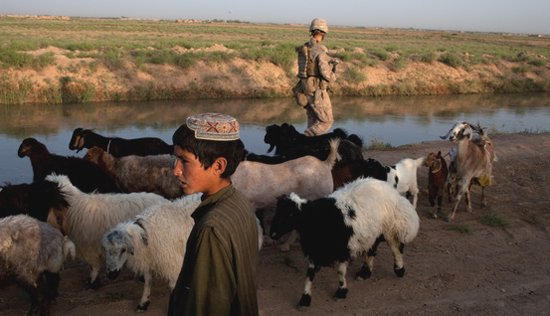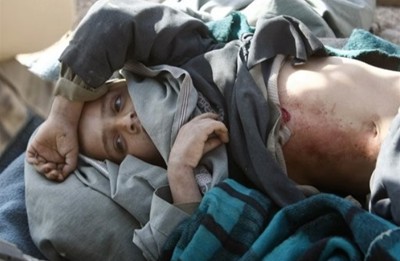By Carlotta Gall

A Marine on patrol in Helmand Province, Afghanistan. (Photo: Tyler Hicks/The New York Times)
LASHKAR GAH — Farmers from the district of Marja, which since February has been the focus of the largest American-led military operation in Afghanistan, are fleeing the area, saying that the Taliban are terrorizing the population and that American troops cannot protect the civilians.
The departure of the farmers is one of the most telling indications that Taliban fighters have found a way to resume their insurgency, three months after thousands of troops invaded this Taliban stronghold in the opening foray of a campaign to take control of southern Afghanistan. Militants have been infiltrating back into the area and the prospect of months of more fighting is undermining public morale, residents and officials said.
As the coalition prepares for the next major offensive in the southern city of Kandahar, the uneasy standoff in Marja, where neither the American Marines nor the Taliban have gained the upper hand and clashes occur daily, provides a stark lesson in the challenges of eliminating a patient and deeply rooted insurgency.
Over 150 families have fled Marja in the last two weeks, according to the Afghan Red Crescent Society in the provincial capital, Lashkar Gah.
Marja residents arriving here last week, many looking bleak and shell-shocked, said civilians had been trapped by the fighting, running a gantlet of mines laid by insurgents and firefights around government and coalition positions. The pervasive Taliban presence forbids them from having any contact with or taking assistance from the government or coalition forces.
“People are leaving; you see 10 to 20 families each day on the road who are leaving Marja due to insecurity,” said a farmer, Abdul Rahman, 52, who was traveling on his own. “It is now hard to live there in this situation.”
One farmer who was loading his family and belongings onto a tractor-trailer on the edge of Lashkar Gah last week said he had abandoned his whole livelihood in Sistan, Marja, as soon as the harvest, a poor one this year, was done.
“Every day they were fighting and shelling,” said the farmer, Abdul Malook Aka, 55. “We do not feel secure in the village and we decided to leave. Security is getting worse day by day.”
“We thought security would be improving,” he said.
Those who remain in Marja voiced similar complaints in dozens of interviews and repeated visits to Marja over the last month.
“I am sure if I stay in Marja I will be killed one day either by Taliban or the Americans,” said Mir Hamza, 40, a farmer from Loye Charahi.
Combat operations in Marja ended at the end of February and the military declared the battle won. But much of the local Taliban, including at least four mid-level commanders, never left, stashing their rifles and adopting the quiet farm life.
A Taliban resurgence was not entirely unexpected, especially now as the poppy harvest ends, freeing men to fight, and as the weather warms up. But the military had seen Marja as a “clear and hold” operation in which the first part, clearing the district of militants, would be wrapped up fairly quickly. In fact, clearing has proved to be a more elusive goal.
By April, life had picked up. People began coming forward to receive government handouts and farmers were happily taking money in return for destroying their poppy crops, whose opium provides a main source of Taliban financing. As villagers saw their neighbors benefiting, more were encouraged to approach the district administration as well, despite Taliban threats.
The change was even more pronounced in the adjacent Nad-e-ali district, where the Taliban have been weakened and security improved thanks largely to the operation in Marja.
But the insurgents’ extensive intelligence network in Marja has remained intact, and they have been able to maintain a hold over the population through what residents have described as threats and assassinations. In April members of the Taliban visited one old man late at night and made him eat his aid registration papers, several residents said, a Mafia-style warning to others not to take government aid.
At the beginning of May, a well-liked man named Sharifullah was beaten to death, accused of supporting the district chief and not paying taxes to the Taliban. His killing froze the community and villagers stopped going to the district administration.
“The Taliban are everywhere, they are like scorpions under every stone, and they are stinging all those who get assistance or help the government and the Americans,” Mr. Rahman, the farmer, said.

Afghan boy Sayd Rahman, 7, who was shot in crossfire near the Taliban stronghold of Marjah. (Photo: AP)
The population remains divided in its support for the Taliban, with a portion providing shelter and assistance to the militants and few daring to oppose them. In some places, people are still lining up for aid, indicating a certain resistance to Taliban strictures.
But many repeat the Taliban contention that the Americans are bent on long-term occupation of Afghanistan and seek to eradicate their religion, Islam, and impose an alien, Western-style democracy.
Villagers complained of indignities imposed by the foreign forces, the arrest and killing of civilians, house searches that violate the ethnic Pashtuns’ sense of honor and the sanctity of the home, and checkpoints where they are forced to lift up their shirts, which is deeply shaming for Afghans, to show that they are not carrying explosives.
Yet they also say that the American Marines are good with the people, only shoot at those who shoot at them, and are showing greater restraint than the British forces who came before them. Farmers tell stories of how the Marines pursue Taliban fighters but leave the farm workers alone, and how in the last week four known insurgents have been killed in airstrikes as they were laying roadside bombs at night.
Nevertheless Afghans express frustration that the American military, which defeated the Taliban so resoundingly in 2001, cannot clear Marja, a district of 100 square miles, of Taliban insurgents that residents estimate number no more than 200.
More Taliban fighters have arrived in recent weeks, slipping in with the itinerant laborers who came to work the poppy harvest and staying on to fight, villagers and officials said. Haji Gul Muhammad Khan, tribal adviser to the governor of Helmand Province, said he had reports of Taliban arriving in the area in the last three or four days.
Everyone in Marja knows the Taliban, since they are village men who never left the area although they quit fighting soon after the military operation. Gradually they found a stealthier way of operating, moving around in small groups, often by motorbike or on foot.
They fire several shots at an American patrol and then flee, or throw aside their weapons and pick up spades, posing as innocent farmers. At least three midlevel Taliban commanders were seen operating in the area in recent weeks, moving among the farms, staying in different houses every night, and asking for food and shelter from the villagers as they go.
The villagers do not dare give them away to the Americans because they are local men and can exact revenge, villagers said.
“We know who the Taliban are,” said Muhammad Ismail, 35, a farmer from Loye Charahi said. “When they attack the police or the Americans, they put down their weapons and sit down with ordinary people. We cannot say a word against them, they know us and we know them pretty well. We know Taliban are killing people and threatening people, but we cannot stand against them, or tell Americans or police about their whereabouts.”
Mr. Khan, the governor’s adviser, expects a further exodus of civilians. “People are just waiting for the harvest to be over and then they will leave,” he said.
C. J. Chivers and an Afghan employee of The New York Times contributed reporting from Marja, and Taimoor Shah from Lashkar Gah.



